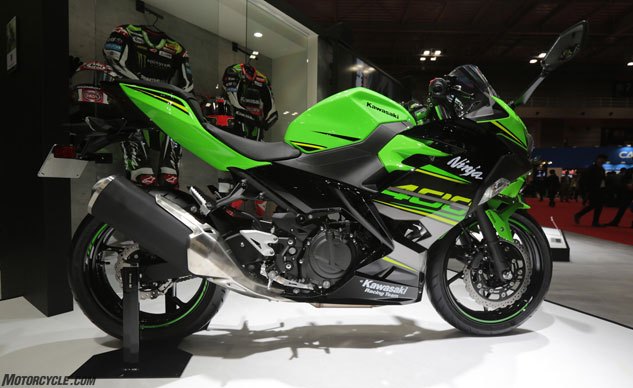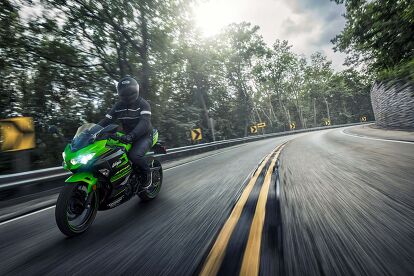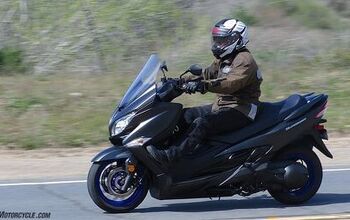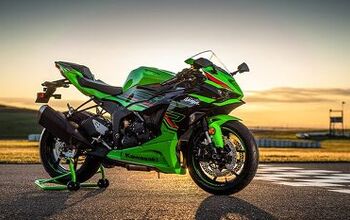First Look: 2018 Kawasaki Ninja 400

Ninja 400 replaces the Ninja 300
UPDATE: We’ve added photos of the 2018 Kawasaki Ninja 400 from to Tokyo Motor Show where it debuted.
As expected, Kawasaki has replaced its Ninja 300 with a new, larger Ninja 400, setting a new bar for the entry-level sportbike class with a 399cc powerplant. After years with the Ninja 250 and more recently the Ninja 300, Kawasaki acknowledged the recent influx of larger competitors such as the Yamaha R3 and KTM RC390 by introducing this new 2018 Ninja 400.
As with the 250 and 300 before it, the Ninja 400 is powered by a parallel-Twin engine. To reach 399cc, the Ninja 400’s engine has a 70.0 mm bore and a 51.8 mm stroke (compared to 62.0 mm by 49 mm for the Ninja 300). Boasting 44.8 hp at 10000rpm and 28.0 lb-ft. at 8000 rpm, the Ninja 400 claims a significant performance increase over the Ninja 300. While the extra 103cc has a lot to do with that, Kawasaki also increased the size of the airbox and modified the downdraft intake for a shorter, more direct airflow path. Kawasaki also redesigned the radiator fan cover to push hot air outwards away from the rider.
Like the Ninja 300, the 400 uses an assist and slipper clutch, but with a new, more compact design and (according to Kawasaki) a 20% lighter clutch lever pull.
The Ninja 400 uses a new trellis frame instead of the Ninja 300’s semi-double cradle chassis. Kawasaki says the new frame design optimizes rigidity while helping reduce weight, contributing to the Ninja 400’s claimed 370.4 pounds (which Kawasaki says is 17.6 pounds lighter than the Ninja 300). Also helping lower the weight is a swingarm mounting plate which allows the swingarm to connect to the rear of the engine without needing frame cross members.
The 41mm telescopic fork is beefier than the Ninja 300’s 37mm fork, offering more rigidity. At the rear, the Ninja 400 uses a five-way preload adjustable monoshock. The braking system is comprised of a single 310mm front disc with a two-piston caliper and a 220mm rear disc with a dual-piston caliper. ABS is offered as standard (at least, for Europe.)
The Ninja 400’s fairing is inspired by the Ninja H2, giving the impression of a larger motorcycle. According to Kawasaki, the larger bodywork improves airflow around the rider compared to the Ninja 300’s fairing design.
Poking at some of its competitors, Kawasaki says the Ninja 400 offers a more comfortable, less extreme riding position. The clip-on handlebars are positioned on top of the fork tubes, and the grips are positioned closer together than on the Ninja 300, while the footpegs are positioned slightly forward.
Other details include an LED taillight, LED headlights, the same instrument cluster as the Ninja 650, a 30.9-inch seat height and a thicker seat than the Ninja 300. The Ninja 400 also has a 3.7 gallon tank, which is smaller than the Ninja 300’s 4.5 gallon tank. The smaller tank does help contribute to the lighter weight and Kawasaki says the Ninja 400 can still get a range of 350 km (217.5 miles) on a single tank.
In Europe, the 2018 Kawasaki Ninja 400 will be offered in a KRT edition Lime Green/Ebony or Metallic Spark Black. As of this writing, the Ninja 400 has not been announced for the U.S., but we expect to hear news soon as it has been certified by the California Air Resources Board.
2018 Kawasaki Ninja 400 Specifications | |
|---|---|
| Engine Type | Liquid-cooled, 4-stroke Parallel Twin |
| Displacement | 399 cc |
| Bore and Stroke | 70.0 x 51.8 mm |
| Compression ratio | 11.5:1 |
| Valve system | DOHC, 8 valves |
| Horsepower | 44.8 hp at 10000 rpm (claimed) |
| Torque | 28.0 lb-ft. at 8000 rpm (claimed) |
| Fuel system | Fuel injection: ø32 mm x 2 |
| Ignition | Digital |
| Starting | Electric |
| Lubrication | Forced lubrication, wet sump |
| Transmission | 6-speed, return |
| Final drive | Chain |
| Clutch | Wet multi-disc, manual |
| Frame | Trellis, high-tensile steel |
| Front Suspension | ø41 mm telescopic fork with 4.7 inches travel |
| Rear Suspension | Bottom-Link Uni-Trak, gas-charged shock with adjustable preload with 5.5 inches travel |
| Front Tire | 110/70R17 M/C 54H |
| Rear Tire | 150/60R17 M/C 66H |
| Front Brake | Single semi-floating ø310 mm petal disc with single balanced actuation dual-piston caliper |
| Rear Brake | Single ø220 mm petal disc with dual-piston caliper |
| Caster (rake) | 24.7° |
| Trail | 92 mm (3.6 inches) |
| Steering angle (left/right) | 35°/ 35° |
| Overall length | 1,990 mm (78.3 inches) |
| Overall width | 710 mm (28.0 inches) |
| Overall height | 1,120 mm (44.1 inches) |
| Wheelbase | 1,370 mm (53.9 inches) |
| Ground clearance | 140 mm (5.5 inches) |
| Seat height | 785 mm (30.9 inches) |
| Curb mass | 168 kg (370.4 pounds), claimed |
| Fuel capacity | 14 liters (3.7 gallons) |

Dennis has been a part of the Motorcycle.com team since 2008, and through his tenure, has developed a firm grasp of industry trends, and a solid sense of what's to come. A bloodhound when it comes to tracking information on new motorcycles, if there's a new model on the horizon, you'll probably hear about it from him first.
More by Dennis Chung












































































Comments
Join the conversation
"is comprised of": INCORRECT
"comprises": CORRECT
Edging ever closer back to my first bike, the EX500. That was a bike I never really out grew. My ego told me I needed something more so I traded up to a Sprint ST. I think this Ninja 400 will be a great first bike like the EX500 was.